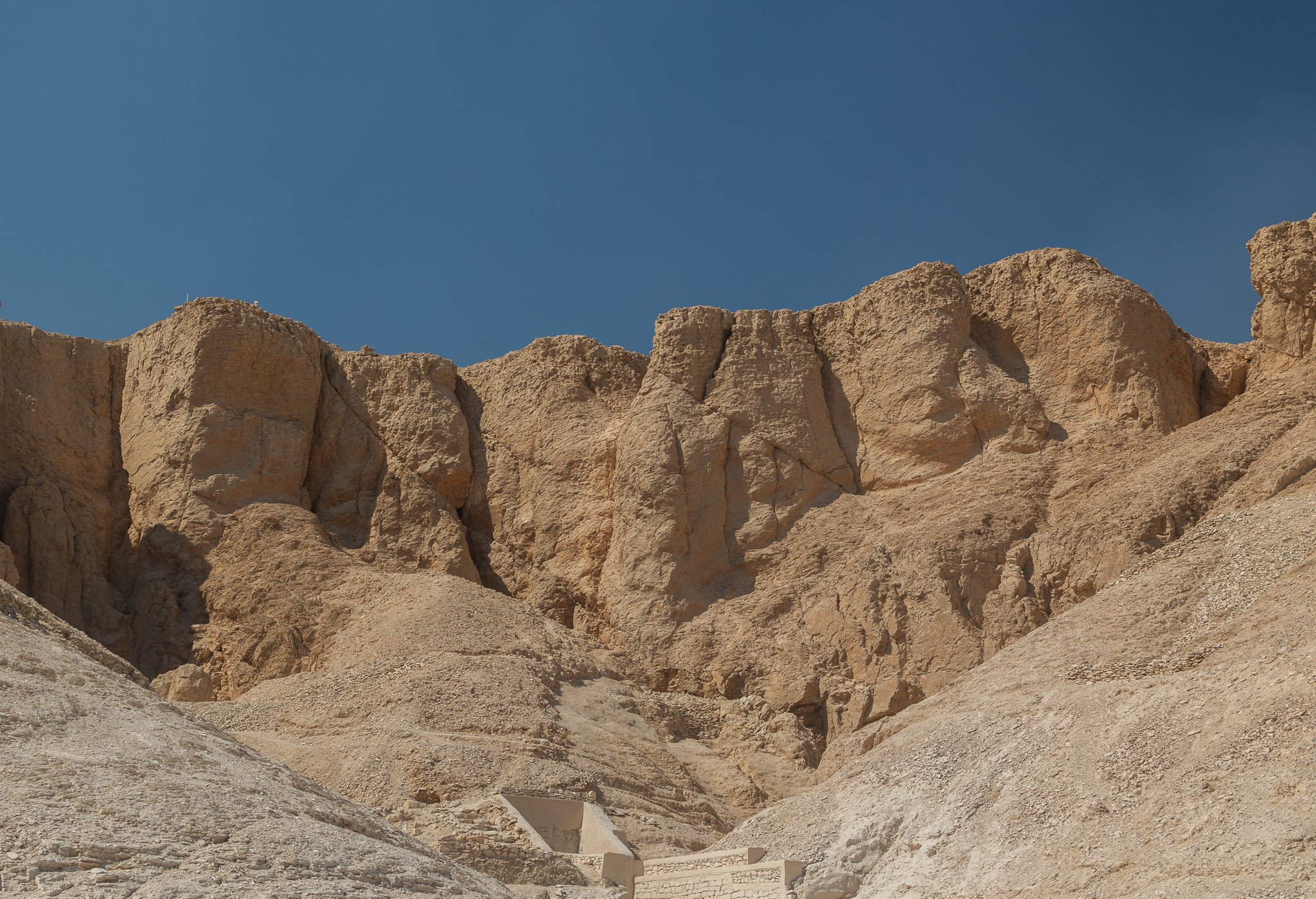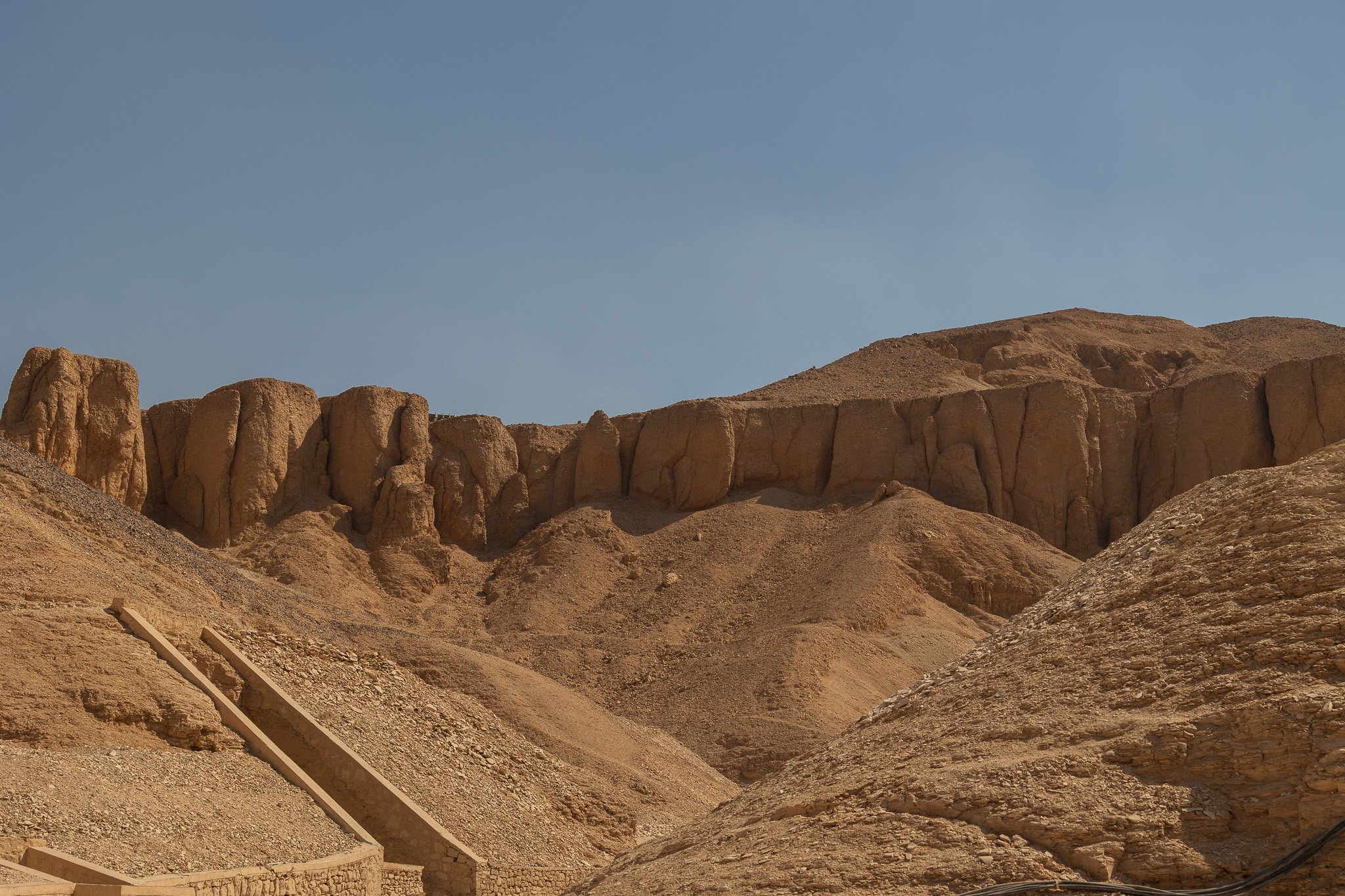Amidst the anticipation for the new GEM unveiling its treasures from King Tutankhamun's tomb, I couldn't resist veering off course to explore the actual Tomb of Tutankhamun in the Valley of the Kings. Nestled on the west bank of the Nile, near the former city of Thebes, now Luxor, this expansive dry valley with its dense limestone caves and tunnels served as the final resting place for Ancient Egyptian pharaohs and nobility.
Despite the initial illusion of a desolate desert landscape, the reality unfolds with 63 tombs spanning five centuries (16th to 11th century BCE) and 20 presumed unfinished pits. These tombs, repositories of kings, their families, servants, and an array of possessions vividly express the ancient Egyptians' profound belief in the afterlife.
Regrettably, like many historical artifacts in Egypt, these tombs have weathered the passage of time, bearing the scars of floods, looting, and the impact of tourism. Restoration endeavours now employ dehumidifiers, glass screens, and controlled access to combat the adverse effects of carbon dioxide, friction, and humidity left by visitors. In particular, an average of 2.8g per person of human sweat left in the chambers has affected the reliefs and pigments of the wall paintings.
Each tomb, numbered in the order of discovery, tells a unique story. Among them, KV-62 stands out – the final resting place of King Tutankhamun. Venturing with a guide, my journey unfolded through three tombs: KV-2 (Rameses IV), KV-6 (Rameses IX), and KV-11 (Rameses III), culminating in the iconic KV-62.
KV-2 is the burial tomb of Rameses IV, who reigned for 22 years and died in 1150 BCE. The tomb boasts a simplistic design with vibrant scenes depicting deities and celestial phenomena. The tomb has a length of 88.7m on a downward slope consisting of three corridors, then a chamber and the burial chamber, plus some smaller chambers that would have contained furniture and other objects. The vivid pigmentation surprised me, with colours like indigo, ochre, and mustard retaining their intensity after millennia.
Moving to KV-6, the burial tomb of Rameses IX, who reigned for 18 years. Running 105 metres into the hillside, the tomb begins with a gate and a shallow descending ramp. Following on from the ramp come three successive stretches of the corridor: a chamber, an unfinished pillared chamber and then the burial chamber. Only half of the originally planned decoration was completed at the time of Rameses IX's death. This tomb was my favourite, with images depicting stories guiding the deceased to the afterlife. Images of people King Rameses decapitated demonstrate his "power", and vivid scenes offer insights into the judgment of souls.
KV-11 is the burial tomb of Rameses III, the King of ancient Egypt who defended his country against foreign invasion in three great wars, thus ensuring tranquillity during much of his reign. In his final years, however, he faced internal disturbances, and he was ultimately killed in an attempted coup d’état. The tomb's chambers reveal scenes of protective deities and demons guarding the king's burial and rebirth. In particular, the tomb narrates his life of foreign wars, internal strife, and a foreboding three-headed snake symbolizing ill fortune –– if the snake faces away from you, it's good, and if it faces you, you are in trouble.
Finally, the pinnacle awaited at KV-62 – Tutankhamun's tomb. The tomb of the Eighteenth Dynasty King Tutankhamun (c.1336–1327 BCE) is world-famous because it is the only royal tomb from the Valley of the Kings discovered relatively intact. Discovered in 1922 by Howard Carter, this tomb remains unparalleled in its intact state.
Tutankhamun was a relatively minor pharaoh, made famous because his tomb is the only one in the valley that was discovered with its contents still inside, not by the grandeur of his tomb relative to the others. Though small, it housed approximately 5,000 artifacts, providing a glimpse into the royal palace's daily life and Tutankhamun's personal effects. These objects include things that Tutankhamun would have used daily, such as clothes, jewellery, cosmetics, incense, furniture, chairs, toys, vessels made of various materials, chariots, and weapons.
But the real treasure was the magnificently decorated sarcophagus with the young king’s remains inside. When they discovered the tomb, it had the golden mask overtop (now in the Cairo Museum), and when they pulled off the mask, allegedly, this action pulled his heart out with it! So maybe that's why the only parts we see are King Tut’s mummified head and feet?
The tombs of pharaohs in ancient Egypt were often filled with traps and obstacles to prevent grave robbers from stealing the buried treasures. The tombs were designed to be difficult to access, and various traps and mechanisms were implemented to deter or trap potential thieves. The Egyptians buried their dead so well that King Tut wasn’t discovered until 1922, and they anticipate many more tombs yet to be discovered.
And so, with a newfound appreciation, my journey through the Valley of the Kings reaffirms the grandeur of ancient Egypt and the intricate dance between preserving history and satiating our curiosity. Now, the mention of King Tut invokes not just the comedic charm of Steve Martin* but the awe-inspiring reality of standing amidst millennia-old wonders.
*Now, when I die,
Don't think I'm a nut,
Don't want no fancy funeral,
Just one like ole king Tut.
If you are new to the Karl Chronicles, get caught up on our expedition around the world! Start here 150 highlights from 150 Chronicles
Then get caught up on the rest of our journey, click here for more Karl Chronicles
The Karl Journey is now registered as an official expedition with the Royal Geographical Society


























